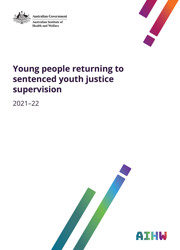Summary
This report presents data on the number of young people released from a supervised youth justice sentence who then returned – that is, young people who received another supervised sentence after the end of their first, or index sentence. Supervised sentences include both community-based and detention sentences.
Content warning: This content contains information some readers may find distressing as it refers to young people’s experiences of youth justice. First Nations young people are also over-represented in the data. If you or someone you know needs help, contact Lifeline: 13 11 14 or 13YARN (13 92 76). Visit Support for a list of support services.
Birth cohort: key findings
The birth cohort analysis examines the proportion of young people born between 1990–91 and 2003–04 who returned to sentenced supervision after their first supervised sentence (that is, the rate of return), using their entire youth justice supervision history between ages 10–17.
The majority of young people do not return to sentenced supervision
About 3 in 5 (59%) young people under sentenced youth justice supervision at some time between 2000–01 and 2021–22 did not return to sentenced youth justice supervision.
Young people with a first supervised sentence of detention were more likely to receive an additional supervised sentence (51%) than young people with a first supervised sentence of community-based supervision (41%).
Of the young people aged 10–17 under sentenced youth justice supervision between 2000–01 and 2021–22:
- among those with a first supervised sentence of community-based supervision, young people aged 10–12 at first sentenced supervision were highly likely to return at some point, with a return rate of 90%
- males were more likely than females to receive an additional supervised sentence before the age of 18 (43% and 36%, respectively)
- First Nations young people were more likely than non-Indigenous Australians to receive an additional supervised sentence before the age of 18 (55% and 34%, respectively).
Supervision cohort: key findings
The supervision cohort analysis examines the rate of return for young people released from a supervised sentence during 2020–21 whose age made them eligible to return to youth justice supervision within 1 year (aged 10–16 when released). It includes young people released from their first ever supervised sentence, and those who had already had a prior episode of sentenced supervision.
This analysis complements the birth cohort analysis, as it measures the number of returns to sentenced supervision within a year for all those released in 2020–21, rather than the number of returns for all young people under youth justice supervision between 2000–01 and 2021–22.
Young people released from sentenced detention are more likely to return to sentenced supervision within 6 and 12 months
Of the young people aged 10–16 released from sentenced supervision in 2020–21 (allowing a 12‑month follow-up period to 30 June 2022):
- 2 in 5 (40%) released from sentenced community-based supervision received another supervised sentence within 6 months, and almost 3 in 5 (57%) within 12 months
- about two-thirds (66%) released from sentenced detention received another supervised sentence within 6 months, and more than 4 in 5 (85%) within 12 months
- those with at least one previous supervised sentence were more likely than those with no previous supervised sentence to return to sentenced supervision. This finding was across supervision types (community-based and detention) and time to return (6 months and 12 months).
Over the 10 years to 2020–21, the 6- and 12-month return rates for young people released from community-based supervision fluctuated. For those released from detention, the return rate within 6 months fluctuated over the period, while the return rate within 12 months remained relatively stable from 2012–13 to 2019–20, rising in the most recent year.
Summary
1. Introduction
- Key concepts
2. Returns to sentenced youth justice supervision while aged 10–17
- Demographics
- Length of first supervised sentence
- Time to return
- Total number of supervised sentences
- States and territories
3. Returns to sentenced youth justice supervision within 6 and 12 months
- States and territories
- Returns over time
- Demographics
- Previously sentenced to supervision
- Length of index sentence
- Returned with a sentence of detention
Appendix: Data and methods
- Data sources
- Linkage method
- Analysis data sets
End matter: Acknowledgments; Glossary; References; List of figures; List of supplementary tables; Related publications



